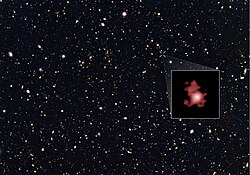Qatar-4b
Qatar-4b is a Super-Jupiter orbiting the star Qatar-4 every 1.8 days. It was discovered in 2016 by the Qatar Exoplanet Survey (QES).
This planet has a very short orbit, with only 1.8 days for it to complete an orbit around Qatar-4. The period corresponds with a separation of around 0.03 AU , which is almost 20 times closer than Mercury is to the Sun. Despite that, it has a perfectly round orbit. Since the host is an active star, Qatar-4 may be destroyed by tidal waves from the star. [5]
Qatar-4b has over 5 times the mass of Jupiter. Despite this, it has a radius that is only 13.5% larger than the latter's. This planet has an effective temperature of 1,385 K, which classifies as a hot Jupiter, and is denser than Jupiter, with about 4 times the density.
This page is based on this
Wikipedia article Text is available under the
CC BY-SA 4.0 license; additional terms may apply.
Images, videos and audio are available under their respective licenses.


